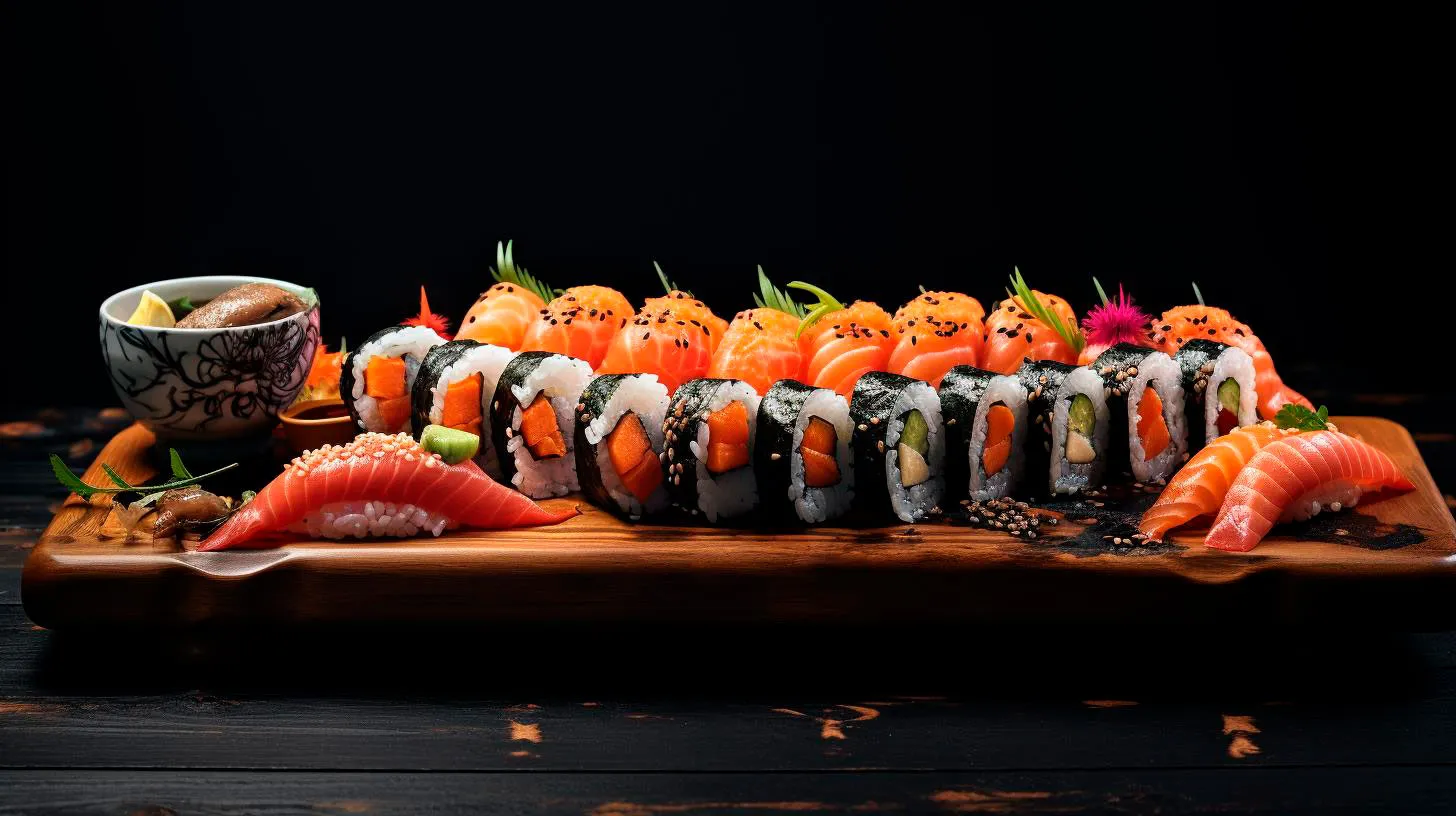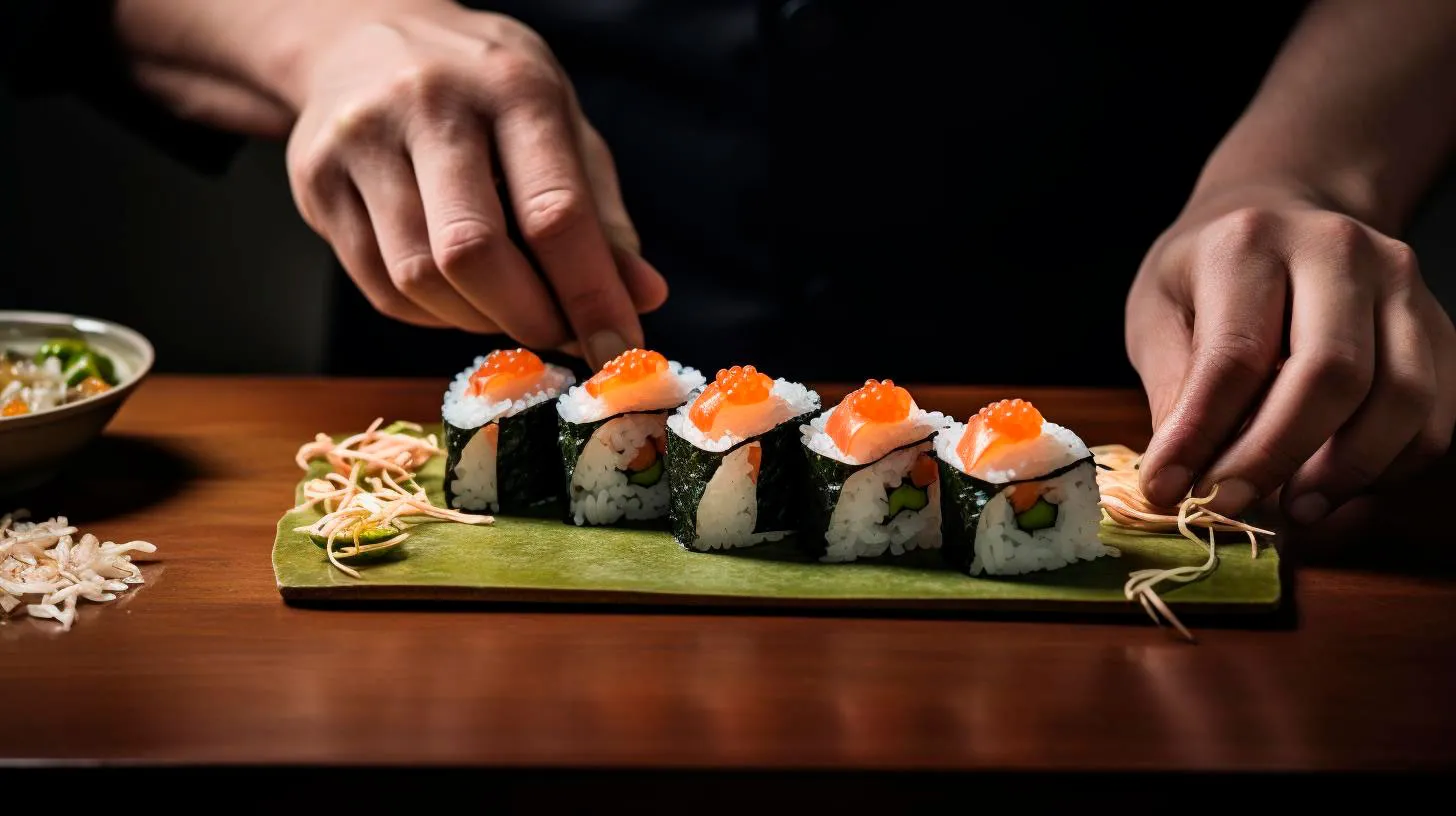Master the Art of Sushi Crafting
In this article, we will explore the fundamentals of sushi crafting, common techniques used, and how you can start mastering this culinary art.
The Fundamentals of Sushi Crafting
Before diving into the techniques, it is important to understand the basic components of sushi:
- Sushi Rice: The foundation of any sushi roll is the sushi rice. It is a short-grain rice that is seasoned with a mixture of rice vinegar, sugar, and salt. The perfect sushi rice should be sticky enough to hold its shape but not too sticky.
- Nori: Nori is a type of seaweed that is used to wrap the sushi roll. It adds a unique flavor and holds the ingredients together.
- Sashimi: Sashimi refers to the thinly sliced raw fish or seafood that is often included in sushi rolls.
- Vegetables and Fillings: Sushi rolls can contain a variety of fillings such as avocado, cucumber, carrot, and more. These ingredients add texture, flavor, and color to the sushi rolls.
Common Techniques Used in Sushi Crafting
Now that you are familiar with the basic components of sushi, let’s explore some common techniques used in sushi crafting:
1. Maki Sushi
Maki sushi, also known as sushi rolls, is one of the most popular sushi varieties. It consists of sushi rice and fillings wrapped in a sheet of nori and cut into bite-sized pieces. Here are some key takeaways:
- Maki sushi can be made with various fillings, including raw fish, cooked seafood, vegetables, and even fruit.
- Common types of maki sushi include California roll, spicy tuna roll, and rainbow roll.
- Using a bamboo sushi mat can help in rolling the sushi tightly and evenly.
2. Nigiri Sushi
Nigiri sushi is a type of sushi that consists of a small mound of sushi rice topped with a piece of sashimi. Here are some features and advantages of nigiri sushi:
- Nigiri sushi showcases the delicate flavor and texture of the sashimi.
- Common types of fish used for nigiri sushi include tuna, salmon, and yellowtail.
- The sushi rice should be shaped by hand, allowing it to gently adhere to the sashimi.
Mastering the Art of Sushi Crafting
Now that you have a basic understanding of the components and techniques used in sushi crafting, here are some tips to help you master this culinary art:
1. Practice Proper Knife Skills
Sharp and precise knife skills are essential for sushi crafting. Invest in a quality sushi knife and practice cutting sashimi and vegetables with precision.
2. Source Fresh and High-Quality Ingredients
The quality of your ingredients greatly affects the taste and overall experience of your sushi. Look for fresh fish and seafood from reputable sources and use seasonal vegetables for the best results.
3. Experiment with Flavors and Textures
Don’t be afraid to get creative and experiment with different flavor combinations and textures in your sushi rolls. Try adding some spicy mayo, sesame seeds, or even a touch of wasabi for an extra kick.
4. Attend Sushi Workshops or Classes
To further enhance your sushi crafting skills, consider attending sushi workshops or classes. These can provide valuable insights, techniques, and inspiration from professional sushi chefs.
5. Presentation Matters
In sushi crafting, presentation is key. Pay attention to the aesthetics of your sushi rolls, creating visually appealing arrangements that make your creations even more enticing.
The Rise of Sushi in the Culinary World
Sushi’s popularity has been steadily increasing over the years. These statistics highlight the growing demand and influence of sushi in the culinary world:
- The global sushi market is expected to reach $27.7 billion by 2025, growing at a CAGR of 3.56% from 2018 to 2025.
- In the United States alone, sushi restaurants generate approximately $2 billion in annual revenue.
- California roll, a popular maki sushi variety, was invented in Los Angeles in the 1960s and played a significant role in introducing sushi to the American palate.
With its unique flavors and intricate presentations, mastering the art of sushi crafting allows you to elevate your culinary skills and impress your friends and family. So, why not embark on this exciting journey and start creating your own sushi masterpieces today?
Unveiling the Secrets behind Sushi Chefs
But what exactly goes into the making of this mouthwatering dish? In this article, we delve into the secrets behind sushi chefs and explore the fascinating world of sushi-making.
The Art of Sushi-making
Sushi-making is not just about putting together raw fish and rice. It is a highly specialized culinary art that requires years of training and dedication. Sushi chefs, also known as Itamae, undergo rigorous apprenticeships lasting several years to acquire the necessary skills. These chefs possess a deep understanding of flavor profiles, textures, and the importance of presentation.
Some of the essential skills that sushi chefs must master include:
- Knife Skills: Sushi chefs are experts in the art of knife handling. They use razor-sharp knives to delicately slice fish and seafood, ensuring perfect cuts with precise thickness.
- Rice Preparation: The quality of sushi greatly depends on the rice preparation. Sushi chefs master the art of cooking and seasoning sushi rice to achieve the perfect balance of stickiness and flavor.
- Seafood Selection: Sourcing the highest quality seafood is crucial for sushi chefs. They carefully select the freshest fish, adhering to strict standards to ensure the utmost quality and taste.
- Flavor Balancing: Sushi chefs possess an incredible palate, allowing them to balance flavors and create harmonious combinations. They understand how to pair different types of fish, vegetables, and seasonings to achieve a perfectly balanced sushi roll.
Key Takeaways from Sushi Chefs
Here are some key takeaways that sushi chefs can teach us:
- Meticulous Attention to Detail: Sushi chefs pay careful attention to every aspect of their craft, from the precise knife cuts to the arrangement of ingredients on the plate. This attention to detail creates a visually stunning and delicious culinary masterpiece.
- Importance of Freshness: Sushi chefs prioritize freshness above everything else. They understand that the quality of the ingredients directly affects the taste. This commitment to freshness ensures an unforgettable dining experience.
- Continuous Learning: Sushi chefs never stop learning and improving their skills. They stay updated with new techniques, ingredients, and trends in the culinary world to offer an innovative sushi experience.
- Presentation Matters: Sushi chefs believe that presentation is just as important as taste. They create visually appealing dishes that are not only a feast for the palate but also for the eyes. The artful presentation enhances the overall dining experience.
Sushi in the Global Culinary Scene
Sushi has become a global phenomenon, with sushi restaurants popping up in cities around the world. The popularity of sushi can be attributed to its unique flavors, healthy ingredients, and the artistry behind its preparation. Here are some fascinating statistics about the global sushi market:
- The global sushi market was valued at $13.8 billion in 2020 and is projected to reach $20.4 billion by 2027, growing at a CAGR of 5.9%.1
- In the United States, sushi consumption has increased by over 400% in the past two decades.2
- Japan consumes approximately 80,000 tons of sushi annually, making it the largest consumer of sushi in the world.3
- Sushi is considered a healthy dining option as it is low in calories and fat while being rich in omega-3 fatty acids and other essential nutrients.4
As the popularity of sushi continues to rise, so does the appreciation for the skill and expertise of sushi chefs. These masters of their craft have dedicated their lives to perfecting the art of sushi-making and providing an unforgettable dining experience. Next time you savor a piece of sushi, take a moment to appreciate the secrets and skills that went into its creation.
Sources:
1Market Research Future
2Forbes
3Japan External Trade Organization
4Healthline
Decipher the Intricacies of Sushi Making
The Art of Sushi Making
Sushi making is not only a culinary skill but also an art form that requires precision, patience, and attention to detail. From selecting the freshest ingredients to crafting visually stunning and flavorful combinations, every step in the sushi making process is crucial to achieving the perfect bite.
To fully grasp the intricacies of sushi making, let’s explore its key elements:
1. Rice, the Heart of Sushi
Sushi rice, known as “sumeshi,” is the foundation of every sushi roll. It requires meticulous preparation, as the rice must be seasoned with vinegar, sugar, and salt to achieve the ideal balance of flavors. Quality sushi rice should be sticky enough to hold together but not overly mushy.
- Key Takeaway: The art of sushi making begins with perfectly cooked and seasoned rice, as it forms the base of each roll.
2. Impeccable Ingredients
The quality and freshness of the ingredients used in sushi making are paramount. From the fish and seafood to the vegetables and condiments, each component should be top-notch to ensure a delightful dining experience. The fish must be exceptionally fresh, allowing its natural flavors to shine through.
- Key Takeaway: Opt for the highest quality ingredients to create sushi that is truly a treat for the senses.
3. Knife Skills, the Precision Touch
One cannot discuss sushi making without acknowledging the importance of knife skills. A sushi chef’s expertise lies in their ability to slice fish with precision, ensuring each piece is the perfect size and shape. The traditional Japanese knife, known as “yanagiba,” is a master tool for achieving those flawless cuts.
- Key Takeaway: Sharpen your knife skills to create visually stunning sushi that showcases the chef’s artistry.
4. The Art of Roll Making
The technique of rolling sushi involves a delicate balance of applying pressure, while ensuring the fillings are evenly distributed. Whether it’s the classic maki roll or the more sophisticated uramaki, mastering the art of rolling takes practice and a keen eye for detail.
- Key Takeaway: Practice makes perfect when it comes to sushi roll making. Have patience and experiment with different fillings to find your own unique combinations.
The Advantages of Making Sushi at Home
While sushi making may seem intimidating, it can be an incredibly rewarding and enjoyable activity to undertake in the comfort of your home. Here are a few advantages of making sushi yourself:
- Economical: Preparing sushi at home is often more cost-effective compared to dining at a sushi restaurant.
- Personalized Creations: Making sushi at home allows you to experiment with various fillings and combinations, catering to your personal taste preferences.
- Healthier Choices: By making sushi at home, you have full control over the ingredients used, allowing you to customize your rolls with wholesome and nutritious options.
Key Takeaways
- Sushi making is an intricate art form that requires precision and attention to detail.
- The quality of ingredients and knife skills significantly impact the final result.
- Perfecting the art of rolling sushi takes practice, but the results are worth it.
- Making sushi at home is a cost-effective and customizable option.
So, the next time you indulge in a plate of sushi, take a moment to appreciate the craftsmanship and technique that went into its creation. Whether you choose to enjoy sushi at a restaurant or embark on your own sushi-making adventure at home, deciphering its intricacies will undoubtedly deepen your appreciation for this iconic Japanese cuisine.
Try a Sushi Workshop: Unleash Your Inner Sushi Master
In this article, we’ll delve into the world of sushi workshops, explore their benefits, and provide you with some key takeaways. Let’s dive in!
What is a Sushi Workshop?
A sushi workshop is an interactive cooking class where participants learn to create their own sushi under the guidance of an experienced sushi chef. These workshops typically provide a hands-on experience, allowing you to roll, shape, and plate your sushi creations. Whether you are a total beginner or a seasoned sushi enthusiast, these workshops cater to all skill levels.
Benefits of Attending a Sushi Workshop
1. Learn from the Experts
Sushi workshops are led by experienced sushi chefs who have mastered the art of sushi making. They will guide you through each step, from selecting the freshest ingredients to perfecting the art of sushi rolling. By learning from the experts, you’ll gain valuable insights and techniques that can elevate your sushi-making skills.
2. Hands-on Experience
One of the biggest advantages of attending a sushi workshop is the hands-on experience it provides. Instead of just watching instructional videos or reading recipes, you get to roll up your sleeves and create your own sushi. This tactile experience allows you to understand the textures and techniques involved and gives you a newfound appreciation for the artistry behind sushi making.
3. Try New Ingredients and Flavors
Sushi workshops often offer a variety of ingredients and flavors that you may not have tried before. From different types of fish to unique sauces and toppings, these workshops provide an opportunity to experiment and expand your palate. You can explore traditional sushi styles or even venture into innovative fusion creations.
4. Bonding Experience
Attending a sushi workshop can be a fantastic social activity, whether you go with friends, family, or as part of a team-building event. Making sushi together fosters collaboration, communication, and teamwork. It’s a chance to connect with others who share your love for sushi and create lasting memories.
Key Takeaways from a Sushi Workshop
- Master sushi-making techniques and gain valuable insights from experienced chefs.
- Develop a deeper appreciation for the artistry behind sushi creation.
- Expand your culinary skills and experiment with new ingredients and flavors.
- Create social bonds through a shared sushi-making experience.
Intriguing Statistics About Sushi
Here are some fascinating statistics that will give you a glimpse into the popularity of sushi:
- According to the Sushi World Summit, sushi sales worldwide amount to over $14 billion annually.
- The United States consumes more than 2 billion servings of sushi each year.
- California rolls, a popular sushi variety, were first introduced in Los Angeles in the 1960s.
- Japan has approximately 45,000 sushi restaurants, accounting for more than half of all restaurants in the country.
- The largest sushi mosaic ever created was made up of 20,647 pieces and measured 37.57 square meters.
As you can see, sushi has become a global culinary phenomenon, and attending a sushi workshop allows you to be part of this cultural trend while refining your sushi-making skills.
In Conclusion
Whether you’re a sushi aficionado or a curious beginner, a sushi workshop offers an exciting opportunity to explore the world of sushi making. From learning from the experts to gaining hands-on experience and trying new flavors, the benefits of attending a sushi workshop are undeniable. So why not roll up your sleeves and unleash your inner sushi master? Sign up for a sushi workshop today and embark on a flavorful journey like no other!



